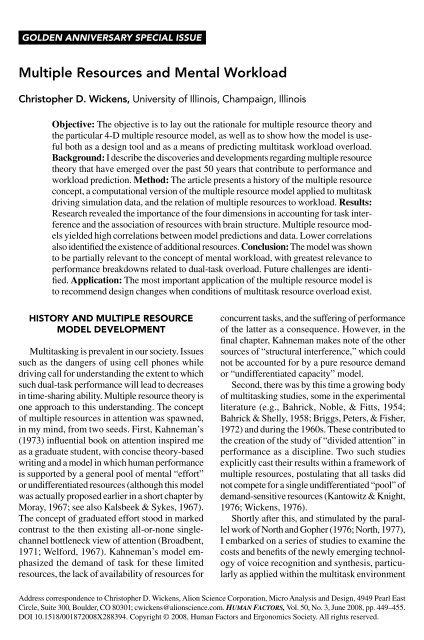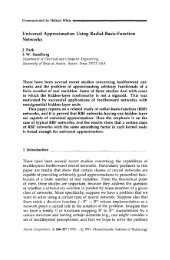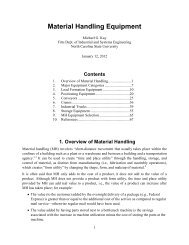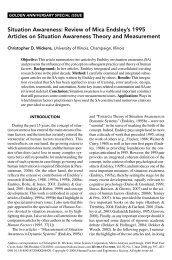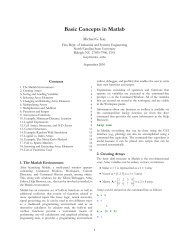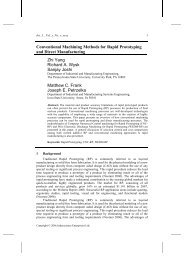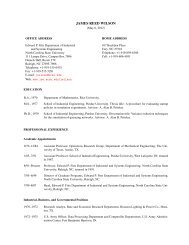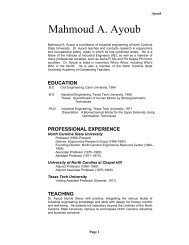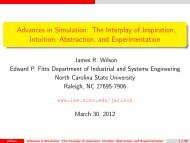Multiple Resources and Mental Workload - ResearchGate
Multiple Resources and Mental Workload - ResearchGate
Multiple Resources and Mental Workload - ResearchGate
Create successful ePaper yourself
Turn your PDF publications into a flip-book with our unique Google optimized e-Paper software.
GOLDEN ANNIVERSARY SPECIAL ISSUE<br />
<strong>Multiple</strong> <strong>Resources</strong> <strong>and</strong> <strong>Mental</strong> <strong>Workload</strong><br />
Christopher D. Wickens, University of Illinois, Champaign, Illinois<br />
Objective: The objective is to lay out the rationale for multiple resource theory <strong>and</strong><br />
the particular 4-D multiple resource model, as well as to show how the model is useful<br />
both as a design tool <strong>and</strong> as a means of predicting multitask workload overload.<br />
Background: I describe the discoveries <strong>and</strong> developments regarding multiple resource<br />
theory that have emerged over the past 50 years that contribute to performance <strong>and</strong><br />
workload prediction. Method: The article presents a history of the multiple resource<br />
concept, a computational version of the multiple resource model applied to multitask<br />
driving simulation data, <strong>and</strong> the relation of multiple resources to workload. Results:<br />
Research revealed the importance of the four dimensions in accounting for task interference<br />
<strong>and</strong> the association of resources with brain structure. <strong>Multiple</strong> resource models<br />
yielded high correlations between model predictions <strong>and</strong> data. Lower correlations<br />
also identified the existence of additional resources. Conclusion: The model was shown<br />
to be partially relevant to the concept of mental workload, with greatest relevance to<br />
performance breakdowns related to dual-task overload. Future challenges are identified.<br />
Application: The most important application of the multiple resource model is<br />
to recommend design changes when conditions of multitask resource overload exist.<br />
HISTORY AND MULTIPLE RESOURCE<br />
MODEL DEVELOPMENT<br />
Multitasking is prevalent in our society. Issues<br />
such as the dangers of using cell phones while<br />
driving call for underst<strong>and</strong>ing the extent to which<br />
such dual-task performance will lead to decreases<br />
in time-sharing ability. <strong>Multiple</strong> resource theory is<br />
one approach to this underst<strong>and</strong>ing. The concept<br />
of multiple resources in attention was spawned,<br />
in my mind, from two seeds. First, Kahneman’s<br />
(1973) influential book on attention inspired me<br />
as a graduate student, with concise theory-based<br />
writing <strong>and</strong> a model in which human performance<br />
is supported by a general pool of mental “effort”<br />
or undifferentiated resources (although this model<br />
was actually proposed earlier in a short chapter by<br />
Moray, 1967; see also Kalsbeek & Sykes, 1967).<br />
The concept of graduated effort stood in marked<br />
contrast to the then existing all-or-none singlechannel<br />
bottleneck view of attention (Broadbent,<br />
1971; Welford, 1967). Kahneman’s model emphasized<br />
the dem<strong>and</strong> of task for these limited<br />
resources, the lack of availability of resources for<br />
concurrent tasks, <strong>and</strong> the suffering of performance<br />
of the latter as a consequence. However, in the<br />
final chapter, Kahneman makes note of the other<br />
sources of “structural interference,” which could<br />
not be accounted for by a pure resource dem<strong>and</strong><br />
or “undifferentiated capacity” model.<br />
Second, there was by this time a growing body<br />
of multitasking studies, some in the experimental<br />
literature (e.g., Bahrick, Noble, & Fitts, 1954;<br />
Bahrick & Shelly, 1958; Briggs, Peters, & Fisher,<br />
1972) <strong>and</strong> during the 1960s. These contributed to<br />
the creation of the study of “divided attention” in<br />
performance as a discipline. Two such studies<br />
explicitly cast their results within a framework of<br />
multiple resources, postulating that all tasks did<br />
not compete for a single undifferentiated “pool” of<br />
dem<strong>and</strong>-sensitive resources (Kantowitz & Knight,<br />
1976; Wickens, 1976).<br />
Shortly after this, <strong>and</strong> stimulated by the parallel<br />
work of North <strong>and</strong> Gopher (1976; North, 1977),<br />
I embarked on a series of studies to examine the<br />
costs <strong>and</strong> benefits of the newly emerging technology<br />
of voice recognition <strong>and</strong> synthesis, particularly<br />
as applied within the multitask environment<br />
Address correspondence to Christopher D. Wickens, Alion Science Corporation, Micro Analysis <strong>and</strong> Design, 4949 Pearl East<br />
Circle, Suite 300, Boulder, CO 80301; cwickens@alionscience.com. HUMAN FACTORS, Vol. 50, No. 3, June 2008, pp. 449–455.<br />
DOI 10.1518/001872008X288394. Copyright © 2008, Human Factors <strong>and</strong> Ergonomics Society. All rights reserved.
450 June 2008 – Human Factors<br />
of the aircraft cockpit. In interpreting the results<br />
of studies in this area, along with the collective<br />
implications of the growing body of multitask<br />
studies referred to earlier, I created, for a chapter<br />
in Attention & Performance VIII, a sort of metaanalysis.<br />
In this analysis, I tried to account for the<br />
variance in time-sharing efficiency revealed across<br />
over 50 different studies by two characteristics:<br />
(a) the extent to which time-shared tasks used the<br />
same versus different processing structures <strong>and</strong><br />
(b) the extent to which “difficulty insensitivity”<br />
was expressed when the two tasks used different<br />
structures. Difficulty insensitivity occurs when an<br />
increase in the difficulty of one task fails to degrade<br />
the performance of a concurrent one.<br />
Out of these two analyses emerged a fairly coherent<br />
picture that “defined” separate resources<br />
in terms of a set of three dichotomies of information<br />
processing, now quite familiar to many<br />
readers <strong>and</strong> expressed (because of their three<br />
dimensions) in the “cube” shown in Figure 1.<br />
• The stages of processing dimension indicates that<br />
perceptual <strong>and</strong> cognitive (e.g., working memory)<br />
tasks use different resources from those underlying<br />
the selection <strong>and</strong> execution of action (Isreal, Chesney,Wickens,<br />
& Donchin, 1980).<br />
• The codes of processing dimension indicates that<br />
spatial activity uses different resources than does<br />
verbal/linguistic activity, a dichotomy expressed in<br />
perception, working memory (Baddeley, 1986), <strong>and</strong><br />
action (e.g., speech vs. manual control; Liu & Wickens,<br />
1992; Wickens & Liu, 1988).<br />
• The modalities dimension (nested within perception<br />
<strong>and</strong> not manifest within cognition or response) indicates<br />
that auditory perception uses different resources<br />
than does visual perception.<br />
Thus, to the extent that two tasks use different<br />
levels along each of the three dimensions, timesharing<br />
will be better. Note that this assertion does<br />
not imply that perfect time-sharing will emerge<br />
whenever different resources are used for two<br />
tasks. For example, time-sharing an auditory <strong>and</strong><br />
visual task will still compete for common perceptual<br />
resources (<strong>and</strong> may also compete for common<br />
code-defined resources if, say, both are linguistic,<br />
involving speech perception <strong>and</strong> reading).<br />
• To these three dimensions was later added a fourth:<br />
visual channels, distinguishing between focal <strong>and</strong><br />
ambient vision (Leibowitz & Post, 1982; Previc,<br />
1998), a nested dimension within visual resources.<br />
Focal vision, primarily (but not exclusively) foveal,<br />
supports object recognition <strong>and</strong>, in particular, high<br />
acuity perception such as that involved in reading<br />
text <strong>and</strong> recognizing symbols. Ambient vision, distributed<br />
across the entire visual field <strong>and</strong> (unlike<br />
focal vision) preserving its competency in peripheral<br />
vision, is responsible for perception of orientation <strong>and</strong><br />
movement, for tasks such as those supporting walking<br />
upright in targeted directions or lane keeping on<br />
the highway (Horrey, Wickens, & Consalus, 2006).<br />
Concurrent with the identification of the first<br />
three dimensions, Navon <strong>and</strong> Gopher (1979) developed<br />
an elegant mathematical theory of multiple<br />
resources that predicts the consequences to<br />
Figure 1. The 4-D multiple resource model.
MULTIPLE RESOURCES AND MENTAL WORKLOAD 451<br />
concurrent task performance of the resource allocation<br />
policy between the tasks, their dem<strong>and</strong> for<br />
limited resources (task difficulty), <strong>and</strong> their dem<strong>and</strong><br />
for common versus distinct resources (e.g.,<br />
resource overlap). After these authors integrated<br />
their theory with my postulation of the identity of<br />
the three (later four) specific resource dimensions,<br />
this one particular version of the multiple resource<br />
model emerged (Wickens, 1980, 1984).<br />
The rationale for defining these four dimensions<br />
is based strongly on the confluence <strong>and</strong> joint satisfaction<br />
of two criteria. First, the four dimensions<br />
defining the model should have neurophysiological<br />
plausibility, in the sense that the dichotomies<br />
have parallels in brain anatomy. In the 3-D + 1<br />
model, they certainly do: (a) Perceptual-cognitive<br />
activity is associated with neural activity posterior<br />
to the central sulcis of the brain, whereas motor<br />
<strong>and</strong> action-oriented activity is anterior. (b) Awellestablished<br />
line of research associates the processing<br />
of spatial <strong>and</strong> verbal material, respectively,<br />
with the right <strong>and</strong> left cerebral hemispheres of<br />
most individuals. Recently work by Just <strong>and</strong> colleagues<br />
(Just et al., 2001; Just, Carpenter, & Miyaki,<br />
2003) has directly associated activity in these areas,<br />
as assessed by functional magnetic resonance<br />
imaging (fMRI) analysis, with dual-task processing<br />
<strong>and</strong> resource dem<strong>and</strong>. (c) Auditory <strong>and</strong> visual<br />
processes are distinctly associated with auditory<br />
<strong>and</strong> visual cortices, respectively. (d) Focal <strong>and</strong> ambient<br />
vision are supported by ventral <strong>and</strong> dorsal<br />
visual pathways, respectively (Previc, 1998).<br />
The second criterion emerged from my human<br />
factors orientation. I felt it important that the<br />
dimensions of the model coincide with relatively<br />
straightforward decisions that a designer could<br />
make in configuring a task or work space to support<br />
multitask activities: Should one use keyboard<br />
or voice? Spoken words, tones, or text? Graphs or<br />
digits? Can one ask people to control while engaged<br />
in visual search or memory rehearsal? These<br />
two criteria, neurophysiological plausibility <strong>and</strong><br />
design decisions, appeared to be fairly well satisfied<br />
in the proposed cube model. Furthermore,<br />
with a few qualifications described at the end of<br />
this article, the model has appeared to st<strong>and</strong> the test<br />
of time in its ability to account for three decades<br />
of dual-task research <strong>and</strong> to support design decisions<br />
(see Wickens, 2002, for a recent summary).<br />
Alternative multiple resource models have been<br />
proposed. Two have been grounded most prominently<br />
in the hemispheric laterality framework<br />
described earlier. Polson <strong>and</strong> Friedman (1988)<br />
focused exclusively on this dimension, whereas<br />
Boles (Boles, 2002; Boles, Bursk, Phillips, &<br />
Perdelwitz, 2007; Boles & Law, 1998), using factor<br />
analysis, has further differentiated auditory <strong>and</strong><br />
visual processing within each hemisphere into<br />
subprocesses such as spatial positional, spatial<br />
quantitative, auditory linguistic, <strong>and</strong> auditory<br />
emotional resources. In this manner, 14 separate<br />
perceptual resources emerge (<strong>and</strong> 17 overall). This<br />
structure also has been evaluated in dual-task paradigms,<br />
revealing that task pairs with a greater<br />
degree of resource overlap suffer greater dualtask<br />
decrements. With the proliferation of more<br />
resources, it becomes more difficult to precisely<br />
associate each with brain locations (<strong>and</strong> therefore<br />
gain full neurophysiological plausibility; Wickens,<br />
2007), but fMRI technology offers promise that<br />
such association might be forthcoming.<br />
Both EPIC (Kieras, 2007; Meyer & Kieras,<br />
1997) <strong>and</strong> a model of threaded cognition (Salvucci<br />
& Taatgen, 2008) invoke multiple resource constructs<br />
within perceptual modalities to account for<br />
dual-task interference patterns. Finally, singlechannel<br />
bottleneck theory (Pashler, 1998) represents<br />
a version of multiple resource theory<br />
(although not cast in those terms), based primarily<br />
on the stage dimension. Here response selection<br />
depends on a very limited supply of resources,<br />
forcing essentially on sequential processing with<br />
high time dem<strong>and</strong> tasks, whereas perceptualcognitive<br />
resources are limited but more available.<br />
As noted by Wickens <strong>and</strong> Holl<strong>and</strong>s (2000), such<br />
multiple resource assumptions are quite consistent<br />
with data from the double-stimulation paradigm<br />
(Pashler, 1989, 1998).<br />
A COMPUTATIONAL MODEL<br />
We have recently developed a relatively simple<br />
computational model of multiple resources, following<br />
a more elaborate version described <strong>and</strong> validated<br />
in Sarno <strong>and</strong> Wickens (1995). This simple<br />
model (Horrey & Wickens, 2003; Wickens, 2002,<br />
2005; Wickens, Dixon, & Ambinder, 2006) predicts<br />
total interference between a time-shared pair<br />
of tasks to be the sum of two components, a dem<strong>and</strong><br />
component (resource dem<strong>and</strong>) <strong>and</strong> a multiple<br />
resource conflict component (degree to which<br />
overlapping resources are required). Each of these<br />
components can range in ordinal values from 0 to<br />
4, providing a simple, intuitive, <strong>and</strong> bounded scale.
452 June 2008 – Human Factors<br />
For the dem<strong>and</strong> component, each task is specified<br />
as being automated (D = 0), easy (D = 1), or difficult<br />
(D = 2), independently of which resources<br />
may be dem<strong>and</strong>ed (e.g., perception vs. response,<br />
auditory vs. visual). Hence, the total task dem<strong>and</strong><br />
can range from 0 (two automated tasks) to 4 (two<br />
difficult tasks).<br />
For the resource conflict component, the two<br />
tasks are compared in the extent to which they<br />
share dem<strong>and</strong>s on common levels of each of the<br />
four dimensions of the 3-D + 1 multiple resource<br />
model, 0, 1, 2, 3, or 4. From the sum of these two<br />
components, a total interference component can<br />
be produced ranging from 0 to 8. This is a simplified<br />
version of the kind of computation that goes<br />
into predicting multitask workload, in software<br />
packages such as IMPRINT © (Laughery, LeBiere,<br />
& Archer, 2006) or MIDAS (Booher & Minninger,<br />
2003; Gore & Jarvis, 2005). Of course, the simple<br />
prediction of the total interference between tasks<br />
does not inform the modeler as to which task suffers<br />
when there is interference, <strong>and</strong> hence added<br />
use must be made of a third, resource allocation<br />
component of the multiple resource model, which<br />
can express, for example, the extent to which driving<br />
versus cell phone conversation suffers when<br />
the two compete for multiple resources. This issue<br />
is discussed later.<br />
Although the validation of a more elaborate<br />
version of this computational model is described<br />
in Sarno <strong>and</strong> Wickens (1995) <strong>and</strong> in Wickens et al.<br />
(2006) in studies demonstrating the importance<br />
of invoking multiple rather than single resource<br />
models, a third validation has been described<br />
(Horrey & Wickens, 2003). The experimental<br />
data, reported in Horrey <strong>and</strong> Wickens (2004), were<br />
those collected in a high-fidelity driving simulator,<br />
as drivers drove on roadways of three differing<br />
dem<strong>and</strong>s (varying traffic <strong>and</strong> curvature) while<br />
engaging in concurrent tasks delivered in different<br />
modalities (auditory, visual head up, <strong>and</strong> head<br />
down). A slightly modified (but conceptually<br />
equivalent) version of the multiple resource formula<br />
was imposed on the task interference data<br />
created by these nine conditions of the 3 × 3 design<br />
for the three tasks of lane keeping, responding<br />
to unexpected hazards, <strong>and</strong> performing the<br />
in-vehicle task. For each task, the dual-task interference<br />
score was assessed by subtracting the<br />
single-task (baseline) performance measure. The<br />
analysis revealed great success in predicting both<br />
hazard response (98% of variance accounted for<br />
by the model) <strong>and</strong> in-vehicle task performance<br />
(92%). However, the model did not predict differences<br />
in lane-keeping performance well at all for<br />
two reasons: (a) separate ambient <strong>and</strong> focal vision<br />
channels which were not included in that version<br />
of the model. Thus, for example, it is the ambient<br />
vision of the upper visual field that allows the<br />
driver to glance downward <strong>and</strong> still keep the car<br />
headed forward in the lane center (Horrey et al.,<br />
2006). (b) Drivers protected lane keeping from<br />
interference (treated it as the primary task), hence<br />
protecting it from variance in interference caused<br />
by structural differences in task resource competition.<br />
This clearly demonstrates the resource allocation<br />
effect.<br />
Before I conclude this section on multiple resource<br />
model prediction, it is important to emphasize<br />
that the primary value of such a model is<br />
predicting relative differences in multitasking between<br />
different conditions or interfaces. Such a<br />
model is not designed to make absolute predictions<br />
of performance – that is, generate a predicted<br />
multitask performance level that can be designated<br />
as acceptable or unacceptable. This issue<br />
as related to workload will be addressed later.<br />
MULTIPLE RESOURCES<br />
AND WORKLOAD<br />
<strong>Multiple</strong> resource theory <strong>and</strong> mental workload<br />
are two related concepts that are often confused.<br />
They overlap but are distinct. To distinguish them,<br />
remember that the multiple resource model architecture<br />
consists of three components related to<br />
dem<strong>and</strong>, resource overlap, <strong>and</strong> allocation policy.<br />
The concept of mental workload relates most<br />
strongly to the first of these, characterizing the<br />
dem<strong>and</strong> imposed by tasks on the human’s limited<br />
mental resources, whether considered as single<br />
or multiple (Moray, 1979).<br />
Importantly, this dem<strong>and</strong> can be conceptually<br />
associated with one of two “regions” of task<br />
dem<strong>and</strong> level (Wickens & Holl<strong>and</strong>s, 2000). The<br />
first is one in which the dem<strong>and</strong> is less than the<br />
capacity of resources available (i.e., there is “residual<br />
capacity” unused in task performance). This<br />
is the ideal state because it means that the worker<br />
will have some resources available should unexpected<br />
circumstances be imposed. The second<br />
region is one in which the dem<strong>and</strong> exceeds the<br />
capacity, <strong>and</strong>, as with any economic system (Navon<br />
& Gopher, 1979), performance will break down.<br />
Sometimes the distinction between these regions
MULTIPLE RESOURCES AND MENTAL WORKLOAD 453<br />
is referred to as a “red line” of workload (Grier,<br />
2008).<br />
Task dem<strong>and</strong>, varying along this continuum,<br />
can result from either single-task dem<strong>and</strong> (e.g.,<br />
driving progressively faster on a winding road imposes<br />
progressively more resource dem<strong>and</strong>, until<br />
lane keeping begins to fail) or dual-task dem<strong>and</strong>.<br />
In characterizing single-task dem<strong>and</strong>, the “multiple”<br />
aspect of multiple resource theory has little<br />
relevance. Furthermore, whether one is doing one<br />
or two tasks in the “residual capacity” region, multiple<br />
resource theory is not fully germane. Only in<br />
the region where overload is imposed by multiple<br />
tasks does multiple resource theory make an<br />
important contribution to mental workload by predicting<br />
how much performance will fail once overload<br />
has been reached (i.e., the size of dual-task<br />
decrements). Here multiple resource theory can of<br />
course also provide guidance as to how redesign<br />
can restore performance to the residual capacity<br />
region.<br />
This distinction between regions is critical because<br />
most measures of workload are designed as<br />
much for the residual capacity region as for the<br />
overload region, if not more so (Gawron, 2008;<br />
Tsang & Vidulich, 2006). Secondary tasks are explicitly<br />
designed to probe “residual capacity” not<br />
used for a primary task; physiological <strong>and</strong> subjective<br />
measures operate across the entire range<br />
of both regions (<strong>and</strong> do not generally distinguish<br />
which resources, within the multiple resource<br />
framework, are used). Thus, the greatest value of<br />
such measures is to ensure that task dem<strong>and</strong>s can<br />
remain within the residual capacity region. Importantly,<br />
some models, such as IMPRINT © (Laughery<br />
et al., 2006) or MIDAS (Gore & Jarvis, 2005) do<br />
have a mental workload component, with task<br />
competition based on multiple resource theory <strong>and</strong><br />
with workload channels defined to correspond to<br />
the dimensions in Figure 1. However, this component<br />
is really intended to predict performance<br />
decrements in the overload region as a result of<br />
multitask requirements, which, as we saw, represents<br />
only one portion of the workload concept.<br />
Such models have been employed in important design<br />
decisions regarding workload <strong>and</strong> crew size<br />
(Booher & Minninger, 2003).<br />
FUTURE CHALLENGES FOR<br />
MULTIPLE RESOURCES<br />
Although the multiple resource model has been<br />
able to account for a good deal of variance in<br />
time-sharing efficiency when heterogeneous<br />
tasks are imposed (Horrey & Wickens, 2003; Liu<br />
& Wickens, 1992; Sarno & Wickens, 1995; Wickens<br />
& Colcombe, 2007; Wickens, Goh, Helleberg,<br />
Horrey, & Talleur, 2003; Wickens, S<strong>and</strong>ry, &<br />
Vidulich, 1983), both the theory <strong>and</strong> the model<br />
remain challenged by a number of issues. These<br />
include the following:<br />
• Adding another level to the modalities dimension,<br />
related to tactile input (Boles et al., 2007)<br />
• The fact that other mechanisms, unrelated to resources,<br />
also account for variance in dual-task performance.<br />
In particular, these relate to confusion<br />
between task elements (e.g., the problems of timesharing<br />
a perception <strong>and</strong> working memory task both<br />
using digits; Hirst & Kalmar, 1987) <strong>and</strong> cooperation<br />
between elements (e.g., dual-task processing supported<br />
by different dimensions of a single object;<br />
Duncan, 1979; Wickens & Holl<strong>and</strong>s, 2000).<br />
• The inability to characterize resource dem<strong>and</strong> on a<br />
single scale, on which the “red line” distinguishing<br />
the reserve capacity from the overload region can be<br />
placed (Hart & Wickens, 1990; Grier, 2008)<br />
• Underst<strong>and</strong>ing what drives the allocation policy. In<br />
the laboratory, this often can be driven by primary<br />
<strong>and</strong> secondary task instructions (Tsang, 2006), but in<br />
the real world, phenomena such as unwanted diversion<br />
of attention to interruptions (Trafton & Monk,<br />
2008), “cognitive tunneling” (Wickens & Alex<strong>and</strong>er,<br />
in press), <strong>and</strong> auditory preemption (Horrey<br />
& Wickens, 2004; Wickens & Colcombe, 2007;<br />
Wickens, Dixon, & Seppelt, 2005) often operate in<br />
ways that are clearly at odds with optimal allocation,<br />
as witnessed by the safety compromise of driving<br />
while using a cell phone (Strayer & Drews, 2007).<br />
Such findings are consistent with recent developments<br />
that allocation policy is a function closely related<br />
to that of the central executive, a construct well<br />
established to account for differences in time-sharing<br />
efficiency (Engle, 2002; Monsell, 2003; Wickens &<br />
McCarley, 2008), as well as to identifiable prefrontal<br />
brain regions (Kramer & Parasuraman, 2007).<br />
Such challenges await the allocation of research<br />
resources to the interested human factors investigator.<br />
ACKNOWLEDGMENTS<br />
I thank Dr. Bill Horrey <strong>and</strong> Dr. David Boles for<br />
their comments on this manuscript.<br />
REFERENCES<br />
Baddeley, A.D. (1986). Working memory. Oxford, UK: Clarendon.<br />
Bahrick, H. P., Noble, M., & Fitts, P. M. (1954). Extra task performance<br />
as a measure of learning a primary task. Journal of Experimental<br />
Psychology, 48, 298–302.
454 June 2008 – Human Factors<br />
Bahrick, H. P., & Shelly, C. (1958). Time sharing as an index of automization.<br />
Journal of Experimental Psychology, 56, 288–293.<br />
Boles, D. B. (2002). Lateralized spatial processes <strong>and</strong> their lexical implications.<br />
Neuropsychologia, 40, 2125–2135.<br />
Boles, D. B., Bursk, J. H., Phillips, J. B., & Perdelwitz, J. R. (2007). Predicting<br />
dual-task performance with the multiple resource questionnaire.<br />
Human Factors, 49, 32–45.<br />
Boles, D. B., & Law, M. B. (1998). A simultaneous task comparison of<br />
differentiated <strong>and</strong> undifferentiated hemispheric resource theories.<br />
Journal of Experimental Psychology: Human Perception <strong>and</strong> Performance,<br />
24, 204–215.<br />
Booher, H., & Minninger, J. (2003). Human systems integration in Army<br />
systems acquisition. In H. R. Booher (Ed.), H<strong>and</strong>book of human<br />
systems integration (pp. 663–698). Hoboken, NJ: Wiley.<br />
Briggs, G., Peters, G., & Fisher, R. (1972). On the locus of the divided<br />
attention effects. Perception & Psychophysics, 11, 315–320.<br />
Broadbent, D. (1971). Decision <strong>and</strong> stress. London: Academic Press.<br />
Duncan, J. (1979). Divided attention: The whole is more than the sum<br />
of its parts. Journal of Experimental Psychology: Human Perception<br />
<strong>and</strong> Performance, 5, 216–228.<br />
Engle, R. W. (2002). Working memory capacity as executive attention.<br />
Current Directions in Psychological Science, 11, 19–23.<br />
Gawron, V. J. (2008). Human performance, workload <strong>and</strong> situation<br />
awareness measures h<strong>and</strong>book, 2nd ed. Boca Raton, FL: CRC Press.<br />
Gore, B. F., & Jarvis, P. A. (2005). New integrated modeling capabilities:<br />
MIDAS’ recent behavioral enhancements (SAW-2005-01-<br />
2701). Warrendale, PA: Society of Automotive Engineers.<br />
Grier, R. (2008). The redline of workload: Theory, research <strong>and</strong> design.<br />
A panel. To be presented at the 52nd Annual Meeting of the Human<br />
Factors <strong>and</strong> Ergonomics Society, September 22–26, in New York.<br />
Hart, S. G., & Wickens, C. D. (1990). <strong>Workload</strong> assessment <strong>and</strong> prediction.<br />
In H. R. Booher (Ed.), MANPRINT: An approach to systems<br />
integration (pp. 257–296). New York: Van Nostr<strong>and</strong> Reinhold.<br />
Hirst, W., & Kalmar, D. (1987). Characterizing attentional resources.<br />
Journal of Experimental Psychology: General, 116, 68–81.<br />
Horrey, W. J., & Wickens, C. D. (2003). <strong>Multiple</strong> resource modeling of<br />
task interference in vehicle control, hazard awareness <strong>and</strong> in-vehicle<br />
task performance. In Proceedings of the Second International Driving<br />
Symposium on Human Factors in Driver Assessment, Training,<br />
<strong>and</strong> Vehicle Design (pp. 7–12). Iowa City: Human Factors Research<br />
Program, University of Iowa.<br />
Horrey, W. J., & Wickens, C. D. (2004). Driving <strong>and</strong> side task performance:<br />
The effects of display clutter, separation, <strong>and</strong> modality.<br />
Human Factors, 46, 611–624.<br />
Horrey, W. J., Wickens, C. D., & Consalus, K. P. (2006). Modeling drivers’<br />
visual attention allocation while interacting with in-vehicle<br />
technologies. Journal of Experimental Psychology: Applied, 12(2),<br />
67–86.<br />
Isreal, J., Chesney, G., Wickens, C. D., & Donchin, E. (1980). P300 <strong>and</strong><br />
tracking difficulty: Evidence for a multiple capacity view of attention.<br />
Psychophysiology, 17, 259–273.<br />
Just, M. A., Carpenter, P. A., Keller, T. A., Emery, L., Zajac, H., &<br />
Thulborn, K. R. (2001). Interdependence of nonoverlapping cortical<br />
systems in dual cognitive tasks. Neuroimage, 14, 417–426.<br />
Just, M. A., Carpenter, P. A., & Miyaki, A. (2003). Neuroindices of cognitive<br />
workload. Theoretical Issues in Ergonomic Sciences, 4, 56–88.<br />
Kahneman, D. (1973). Attention <strong>and</strong> effort. Englewood Cliffs, NJ:<br />
Prentice Hall.<br />
Kalsbeek, J., & Sykes, R. (1967). Objective measurement of mental load.<br />
Acta Psychologica, 27, 253–261.<br />
Kantowitz, B. H., & Knight, J. (1976). Testing tapping time sharing:<br />
Auditory secondary task. Acta Psychologica, 40, 343–362.<br />
Kieras, D. (2007). Control of cognition. In W. Gray (Ed.), Integrated<br />
models of cognitive systems (pp. 327–355). New York: Oxford University<br />
Press.<br />
Kramer, A. F., & Parasuraman, R. (2007). Neuroergonomics: Applications<br />
of neuroscience to human factors. In J. T. Cacioppo,<br />
L. G. Tassinary, & G. G. Berntson (Eds.), H<strong>and</strong>book of psychophysiology<br />
(3rd ed., pp. 704–722). New York: Cambridge<br />
University Press.<br />
Laughery, K. R., LeBiere, C., & Archer, S. (2006). Modeling human<br />
performance in complex systems. In G. Salvendy (Ed.), H<strong>and</strong>book<br />
of human factors <strong>and</strong> ergonomics (3rd ed., pp. 965–996). Hoboken,<br />
NJ: Wiley.<br />
Leibowitz, H., & Post, R. (1982). The two modes of processing concept<br />
<strong>and</strong> some implications. In J. Beck (Ed.), Organization <strong>and</strong> representation<br />
in perception (pp. 343–363). Hillsdale, NJ: Erlbaum.<br />
Liu, Y., & Wickens, C. D. (1992). Visual scanning with or without spatial<br />
uncertainty <strong>and</strong> divided <strong>and</strong> selective attention. Acta Psychologica,<br />
79, 131–153.<br />
Meyer, D. E., & Kieras, D. E. (1997). A computational theory of executive<br />
cognitive processes <strong>and</strong> multiple-task performance: Part 2.<br />
Accounts of psychological refractory-period phenomena. Psychological<br />
Review, 104, 749–791.<br />
Monsell, S. (2003). Task switching. Trends in Cognitive Science, 7,<br />
134–140.<br />
Moray, N. (1967). Where is attention limited? A survey <strong>and</strong> a model.<br />
Acta Psychologica, 27, 84–92.<br />
Moray, N. (1979). <strong>Mental</strong> workload: Its theory <strong>and</strong> measurement. New<br />
York: Plenum.<br />
Navon, D., & Gopher, D. (1979). On the economy of the human processing<br />
systems. Psychological Review, 86, 254–255.<br />
North, R. (1977). Task functional dem<strong>and</strong>s as factors in dual task performance.<br />
In Proceedings of the 21st Annual Meeting of the Human<br />
Factors Society (pp. 367–371). Santa Monica, CA: Human Factors<br />
Society.<br />
North, R., & Gopher, D. (1976). Measures of attention as predictors of<br />
flight performance. Human Factors, 18, 1–14.<br />
Pashler, H. (1989). Dissociations <strong>and</strong> contingencies between speed <strong>and</strong><br />
accuracy: Evidence for a two-component theory of divided attention<br />
in simple tasks. Cognitive Psychology, 21, 469–514.<br />
Pashler, H. (1998). The psychology of attention. Cambridge, MA: MIT<br />
Press.<br />
Polson, M. C., & Friedman, A. (1988). Task-sharing within <strong>and</strong> between<br />
hemispheres: A multiple-resources approach. Human Factors, 30,<br />
633–643.<br />
Previc, F. H. (1998). The neuropsychology of 3-D space. Psychological<br />
Bulletin, 124, 123–164.<br />
Salvucci, D., & Taatgen, N. A. (2008). Threaded cognition: An integrated<br />
theory of concurrent multitasking. Psychological Review, 115,<br />
101–130.<br />
Sarno, K. J., & Wickens, C. D. (1995). The role of multiple resources in<br />
predicting time-sharing efficiency: An evaluation of three workload<br />
models in a multiple task setting. International Journal of Aviation<br />
Psychology, 5(1), 107–130.<br />
Strayer, D., & Drews, F. (2007). Multi-tasking in the automobile. In<br />
D. W. A. Kramer, D. Wiegmann, & A. Kirlik (Eds.), Attention: From<br />
theory to practice (pp. 121–133). New York: Oxford University<br />
Press.<br />
Trafton, J. G., & Monk, C. A. (2008). Task interruptions. In D. A.<br />
Boehm-Davis (Ed.), Reviews of human factors <strong>and</strong> ergonomics<br />
(Vol. 3, pp. 111–126). Santa Monica, CA: Human Factors <strong>and</strong><br />
Ergonomics Society.<br />
Tsang, P. (2006). Regarding time-sharing with convergent operations.<br />
Acta Psychologica, 121, 137–175.<br />
Tsang, P., & Vidulich, M. A. (2006). <strong>Mental</strong> workload <strong>and</strong> situation<br />
awareness. In G. Salvendy (Ed.), H<strong>and</strong>book of human factors &<br />
ergonomics (pp. 243–268). Hoboken, NJ: Wiley.<br />
Welford, A. T. (1967). Single channel operation in the brain. Acta<br />
Psychologica, 27, 5–21.<br />
Wickens, C. D. (1976). The effects of divided attention on information<br />
processing in tracking. Journal of Experimental Psychology:<br />
Human Perception <strong>and</strong> Performance, 2, 1–13.<br />
Wickens, C. D. (1980). The structure of attentional resources. In<br />
R. Nickerson (Ed.), Attention <strong>and</strong> performance VIII (pp. 239–257).<br />
Hillsdale, NJ: Erlbaum.<br />
Wickens, C. D. (1984). Processing resources in attention. In R. Parasuraman<br />
& R. Davies (Eds.), Varieties of attention (pp. 63–101).<br />
New York: Academic Press.<br />
Wickens, C. D. (2002). <strong>Multiple</strong> resources <strong>and</strong> performance prediction.<br />
Theoretical Issues in Ergonomics Science, 3(2), 159–177.<br />
Wickens, C. D. (2005). <strong>Multiple</strong> resource time sharing models. In<br />
N. Stanton, A. Hedge, K. Brookhuis, E. Salas, & H. Hendrick<br />
(Eds.), H<strong>and</strong>book of human factors <strong>and</strong> ergonomics methods (pp.<br />
40.1–40.7). Boca Raton, FL: CRC Press.<br />
Wickens, C. D. (2007). How many resources <strong>and</strong> how to identify them?<br />
Commentary on Boles et al. <strong>and</strong> Vidulich <strong>and</strong> Tsang. Human<br />
Factors, 49, 53–56.<br />
Wickens, C. D., & Alex<strong>and</strong>er, A. (in press). Attentional tunneling <strong>and</strong><br />
task management in synthetic vision displays. International Journal<br />
of Aviation Psychology.<br />
Wickens, C. D., & Colcombe, A. (2007). Dual-task performance consequences<br />
of imperfect alerting associated with a cockpit display<br />
of traffic information. Human Factors, 49, 839–850.
MULTIPLE RESOURCES AND MENTAL WORKLOAD 455<br />
Wickens, C. D., Dixon, S. R., & Ambinder, M. S. (2006). <strong>Workload</strong><br />
<strong>and</strong> automation reliability in unmanned air vehicles. In N. J. Cooke,<br />
H. Pringle, H. Pedersen, & O. Connor (Eds.), Advances in human<br />
performance <strong>and</strong> cognitive engineering research: Vol. 7. Human<br />
factors of remotely operated vehicles (pp. 209–222). Amsterdam:<br />
Elsevier.<br />
Wickens, C. D., Dixon, S. R., & Seppelt, B. (2005). Auditory preemption<br />
versus multiple resources: Who wins in interruption management?<br />
In Proceedings of the Human Factors <strong>and</strong> Ergonomics<br />
Society 49th Annual Meeting—2005 (pp. 463–467). Santa Monica,<br />
CA: Human Factors <strong>and</strong> Ergonomics Society.<br />
Wickens, C. D., Goh, J., Helleberg, J., Horrey, W., & Talleur, D. A.<br />
(2003). Attentional models of multi-task pilot performance using<br />
advanced display technology. Human Factors, 45, 360–380.<br />
Wickens, C. D., & Holl<strong>and</strong>s, J. G. (2000). Engineering psychology <strong>and</strong><br />
human performance (3rd ed.). Upper Saddle River, NJ: Prentice<br />
Hall.<br />
Wickens, C. D., & Liu, Y. (1988). Codes <strong>and</strong> modalities in multiple resources:<br />
Asuccess <strong>and</strong> a qualification. Human Factors, 30, 599–616.<br />
Wickens, C. D., & McCarley, J. (2008). Applied attention theory. Boca-<br />
Raton, FL: Taylor & Francis.<br />
Wickens, C. D., S<strong>and</strong>ry, D., & Vidulich, M. (1983). Compatibility <strong>and</strong><br />
resource competition between modalities of input, output, <strong>and</strong> central<br />
processing. Human Factors, 25, 227–248.<br />
Christopher D. Wickens is a senior scientist at Alion<br />
Science Corporation, Micro Analysis & Design Operations,<br />
Boulder, Colorado, <strong>and</strong> professor emeritus at the<br />
University of Illinois at Urbana-Champaign. He received<br />
his Ph.D. in psychology from the University of<br />
Michigan in 1974.<br />
Date received: September 7, 2007<br />
Date accepted: February 26, 2008


